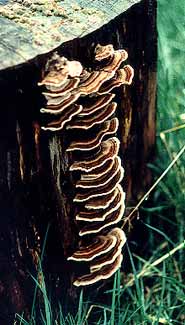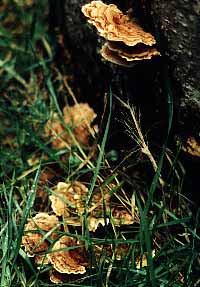
Turkey Tail
Bracket Fungus
"Lichens moist upon the fences,
Twiners close against the logs;
Yellow fungus in the thickets,
Vivid mosses in the bogs."
-Grace Jennings Carmichael
(1867-1904)
(1867-1904)
These photogenic two-inch little rainbows are a shelf or bracket fungus known throughout the United States as Turkey Tail (Trametes versicolor), so-named because they look like miniature renditions of a strutting turkey's fully opened tail. They're elsetimes called Rainbow Brackets, Rainbow Conks, Many-Zoned Polypore, or Multicolor Polypore. As it grows world-wide it has many names. In Japan it called Kawaratake, the Riverbank Mushroom. In China it is Yun zhi, Raincloud Fungus. In the Netherlands they are Elfenbankjes, or Elves' Davenports.
Here along Puget Sound it is one of the most common woodland fungi. With its horizontal "stacked shelf" & vertical rosette growth patterns, & its scallop-shell or fan-shaped concentric stripes of rust-red, gold, brown, green & creamy yellow, it is also one of the most beautiful fungi.
These sprang forth spontaneously from the side of a decaying firewood round that had been left in the garden to serve as an artificial stump & small table. The round was originally used as a footstool to reach a birdfeeder, but a cat would hunker down on the top of the fence, so we moved the feeder but left the round, & two years later the Turkey Tail grew out of it.
Turkey Tail is a "white rot" fungus in that it derives nutrients from the brown lignens in decaying wood, leaving behind the white cellulose. These mushrooms slowly over a great length of time reduce fallen timbers & rotting logs & stumps to nutrients useful to other organisms in a woodland setting or garden.
 It is non-toxic but not regarded as edible because too corky & tough. Peroxides derived from this species are used for biobleaching, such as to give denim bluejeans a washed look before market. It is also used in medicinal teas & general tonic, with a faint sweetness, best mixed with licorice root or gensing or sassafrass bark to serve as a mild decongestant or merely as a pleasant tea whether or not actually boosting the immune system as often claimed.
It is non-toxic but not regarded as edible because too corky & tough. Peroxides derived from this species are used for biobleaching, such as to give denim bluejeans a washed look before market. It is also used in medicinal teas & general tonic, with a faint sweetness, best mixed with licorice root or gensing or sassafrass bark to serve as a mild decongestant or merely as a pleasant tea whether or not actually boosting the immune system as often claimed.It is very old as a folk medicine in China & elsewhere in the world, & has been widely studied for its chemical composition. There is very good evidence that it contains chemicals that shrink tumors with few if any of the side-effects associated with other medications. It is less likely that the widely distributed non-medical-grade commercial tinctures & powders for use in teas & capsules possess the myriad exaggerated health benefits herbal quacks allege for it, but it is harmless enough to be worth trying just so long as it is not an ill individual's primary recourse.
All bracket fungi are polypores. The genus Polypurus was once a catch-all for fungi having pores on the underside, & not shaped like mushrooms. Turkey Tail was formerly known as Polypurus versicolor & then as Coriolus versicolor. Today, however, the many Polypurus spp have been divided into over a hundred genera, with innumberable species.
All polypores are wood-decay funguses usually to be found growing on fallen trees & stumps, but some grow out of the ground attached to buried wood or decaying roots. Not all the polypores are shelf-shaped, but the majority are. Many polypores are "zonate" on the upper surface & look very similar to Turkey Tails, & it is easy to misidentify them, but T. versicolor is by far the most common.
Turkey Tail fruiting bodies are very thin & as pliable as a gnome's ears. They are velvety to the touch on top, creamy white & pourous on the underside. They attach to logs along the back center edge of the fan, showing no evidence of a stem. It is an annual rather than perennial, but can occur at any time of the year & are very persistant & long-lasting.
It will grow on either hardwood or softwood with a preference for the latter, though our volunteer crop is growing on decaying fir. The vivid striping is extremely varied throughout its world-wide range, with some having only stripes of earthy colors, or of black & white, while others have very colorful yellows & oranges & greens. They change as the year progresses & are most colorful early in their development before they are ready to spoor.
It's our intent to preserve this moist & shady little spot for the Turkey Tails for as long as they elect to persist.